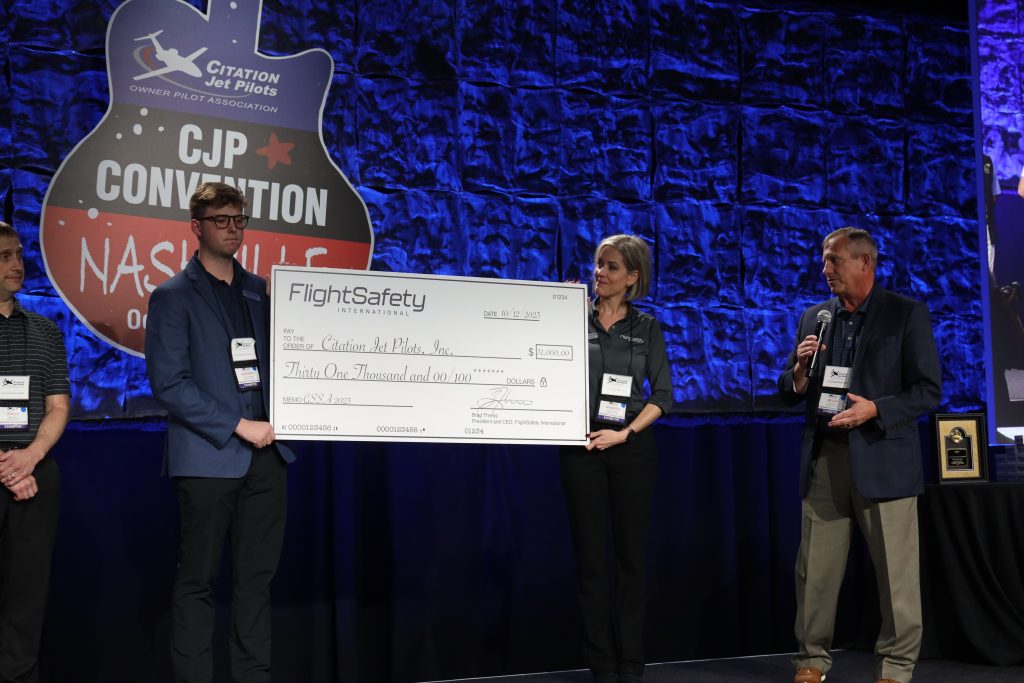As befitting an event that also marks the 15th anniversary of the association’s founding, the Opening Day at CJP 2023 featured a wealth of valuable safety insights and presentations.

CJP Safety Committee Chairman Charlie Precourt launched the discussion of “The Quest for Safety,” noting that CJP’s FOQA (flight operational quality assurance) database now includes more than 5,000 flights that have yielded a wealth of useful information how members operate their Citations.
“We’re learning a lot of really good stuff,” he said. “We are hitting three years without an accident or an incident* which is remarkable. Give yourselves a great hand for that, because there is no other organization in GA that can post this kind of record.”
Precourt then polled Attendees on what CJP offerings they believed offered the most safety benefits to operators, with options ranging from the member forums to the association’s Gold Standard Safety Award. FOQA and the CJP Convention were the top audience responses.
“With all that we’ve been doing the last several years with the safety committee, we cannot yet determine a cause and effect, which of our things is really driving the most results,” he added.
FOQA data also supports the new Safe to Land (STL) 2.0 initiative that expands CJP’s industry-leading landing safety criteria to non-straight-in, visual approaches.
The opening safety session also included insights on safe operations from Rob Switz and Stephanie Goetz from NetJets and FlightSafety’s Richard Meikle.
With more than 185 million miles flown fleetwide over the past 12 months to more than 2,100 airports around the globe, Switz noted that approach checklists and briefings are a critical part of maintaining NetJets’ safety culture.
“We’re continually briefing,” he said. “Our checklist includes what we’re required to brief, just to make sure we cover everything, [but] the briefing also allows us to flex for [a challenging] approach and change the SOPs if necessary, because we can’t write SOPs for every single scenario.”

In another example that approach briefings should be more than simply reading from a checklist, Meikle discussed a June 2022 incident involving a FedEx Boeing 757-200 operating an overnight repositioning flight from Alliance Airport in Fort Worth, TX to Tulsa International Airport. The flight crew was cleared to land on 18L with 10,000 feet available, but they actually touched down on 18R with only 5,101′ available for landing in clear, visual conditions.
In addition to available visual cues of their mistake, the NTSB also noted various flight instruments that all indicated a problem on approach, as they were tuned to 18L. “The RAAS (runway awareness and advisory system) actually called out, ‘approaching one-eight-right,’” Meikle noted. “Shortly thereafter, the captain says, ‘the glideslope shows we’re really high and the PAPI shows us low.’
“That should have absolutely been a call for them to say something is not right,” he continued. “If your Spidey senses are saying this doesn’t feel right, don’t try and figure it out in the last 30 seconds of the flight. We must have every barrier we can between us and a bad event.”
Goetz, a first officer with NetJets, emphasized the important safety role Companions can perform on the flight deck in such scenarios.
“I was a Companion before I was ever a pilot,” she said, pointing to her experiences flying with her husband, Endre Holen. “These companions are incredibly intelligent, qualified, and very competent to be able to do many of the things that help take workload off us as pilots in the cockpit.
“The key is to make sure you make the environment welcoming, make sure you make it a place for your companion, significant other for a place that is one that they want to be in and sit in,” she added.
The morning session closed with Textron Aviation’s Peter Basile, who offered a deeper look into the December 2016 loss of a CJ4 on takeoff from Cleveland’s Burke Lakefront Airport (BKL).
In its probable cause report, the NTSB cited pilot fatigue and differences in instrumentation and autopilot operation between the CJ4 and the pilot’s previous aircraft, a Citation Mustang, as contributing to spatial disorientation resulting in CFIT.
Basile urged attendees to check out the FAA’s Spatial Disorientation in Aerospace Medicine Reference Collection to learn more about how to avoid similar situations. “I love this resource,” he said. “It’s full of good information that can help make you safer pilots.”
In particular, Basile noted a series of spatial disorientation videos produced by the U.S. Air Force and made available to the FAA. “Most of these are three minutes or less,” he said, “but they examine all the different types of spatial disorientation you may encounter, including things like flicker vertigo, the giant hand illusion and graveyard spiral.”

The day’s safety sessions concluded with the presentation of CJP wings to members who have achieved 1,000, 2,000 and 3,000 hours of Citation flying and recognition of the 62 CJP owner/pilots who earned the Gold Standard Safety Award in 2023. This also included presentation of a check for $31,000 from FlightSafety Textron Aviation Training to cover the CJP dues for those 62 members for the coming year.
All photos by Stratton DV Imaging
*NOTE: At the time of the convention, the CJP fleet had experienced one, non-reportable, ground contact incident over the cited time period. Following the convention, a CJP member was involved in a non-injury accident in which their aircraft was struck on landing at Houston Hobby (HOU) by an aircraft that departed from the intersecting runway without takeoff clearance.